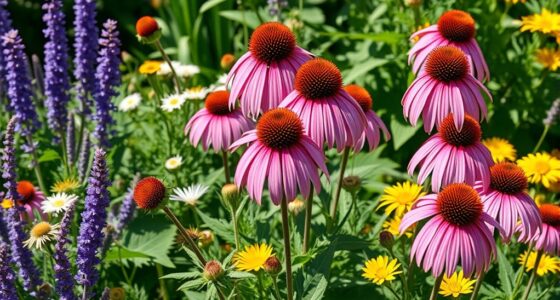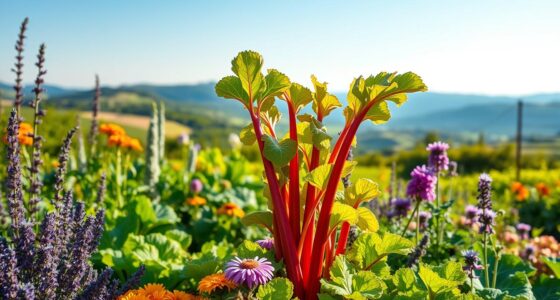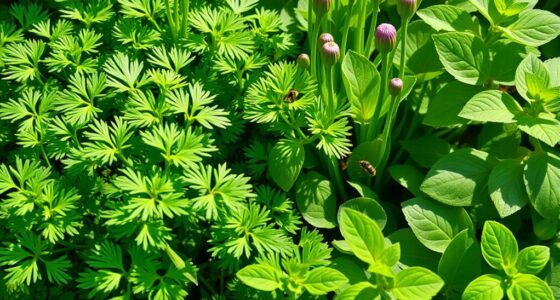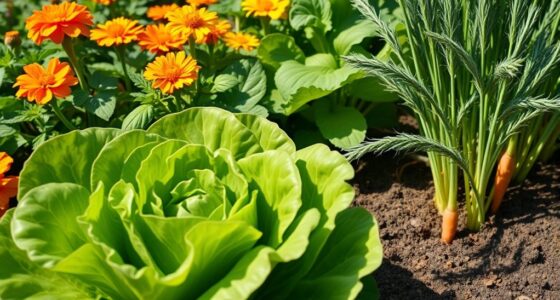Imagine walking into your garden, the sweet aroma of ripening blueberries filling the air. As you gently pluck the plump, juicy fruits from their branches, a sense of accomplishment washes over you. One of the keys to achieving that moment of joy lies in knowing the best companion plants for blueberries. These fabulous plants can not only enhance the flavors and abundance of your crop but also create a thriving ecosystem that nurtures your garden. In this blueberry companion planting guide, you’ll learn how specific plants can work harmoniously alongside your blueberries, ensuring they grow strong and healthy while attracting beneficial insects and repelling pests.
Key Takeaways
- Companion plants for blueberries enhance growth and minimize pests.
- Choosing the best plants to grow with blueberries is crucial for a bountiful harvest.
- Understanding plant compatibility fosters a healthier garden ecosystem.
- Specific herbs, vegetables, and flowers can boost your blueberry plants’ vitality.
- The right companion planting can lead to increased pollination and yields.
- Soil health and overall garden balance improve with proper companion plants.
Understanding Blueberries’ Growing Needs
To cultivate healthy blueberry plants, understanding their specific growing needs is essential. These plants thrive in certain conditions, which can influence their health, yield, and overall success in your garden.
Soil Conditions for Healthy Growth
The foundation of any successful blueberry plant begins with the right soil conditions for blueberries. Blueberries love acidic soil that has a pH ranging from 4.0 to 5.5. To ensure optimal growth, it is important to provide well-draining soil that helps prevent water accumulation around the roots. Adding organic matter such as peat moss or compost can enhance soil structure, contributing to a more suitable environment for these plants.
Sunlight Requirements for Blueberries
Your blueberry plants flourish under full sun, requiring at least 6 to 8 hours of direct sunlight each day. This exposure not only promotes healthy growth but also aids in the development of sweet, flavorful berries. Placing your plants in a spot that maximizes sunlight will improve your overall yield and the taste of the berries.
Watering Needs for Blueberry Plants
Watering is crucial to meet the blueberry plant needs, especially given their shallow root systems. These plants prefer soil that remains consistently moist but not waterlogged. Regular checks for moisture levels will help you manage irrigation effectively. It’s important to use mulch to retain moisture while also promoting healthy soil conditions, providing an ideal habitat for beneficial organisms.

Benefits of Companion Planting for Blueberries
Exploring the benefits of companion planting for blueberries unveils a world of advantages that can transform your garden. By integrating certain plants with your blueberries, you can harness natural pest control strategies, improve pollination, and enhance soil health. Let’s dive into these key benefits.
Pest Control and Natural Predators
Utilizing companion plants can significantly enhance your pest control efforts. Certain herbs and flowers attract beneficial insects, such as ladybugs and lacewings, which serve as natural predators to harmful pests. This natural pest control reduces the reliance on chemical pesticides, creating a healthier ecosystem for your blueberries.
Enhanced Pollination and Yields
Companion planting can play a vital role in improving yields with companion plants. By attracting pollinators like bees and butterflies, you will increase the pollination of your blueberry plants. This results in a more bountiful harvest, as a higher rate of pollination translates into more fruit.
Soil Health Improvement
Integrating legumes and specific herbs can improve soil quality, making it more fertile for your blueberry plants. These companion plants fix nitrogen in the soil, boosting nutrient levels and fostering healthier growth. A well-nourished soil contributes to the overall vitality and productivity of your garden.
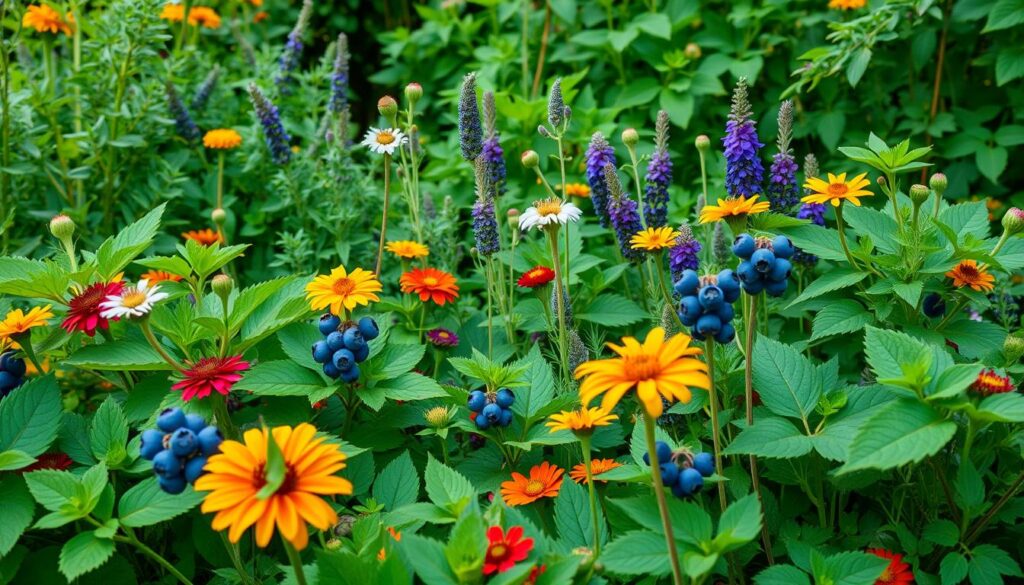
Ideal Companion Plants for Blueberries
Choosing the best plants to pair with blueberries can significantly enhance their growth and yield. Various herbs, vegetables, and flowers can thrive alongside blueberry plants, creating a flourishing garden ecosystem. These ideal companions for blueberry plants not only support healthy growth but also invite pollinators that are essential for fruit production.
Herbs that Thrive Alongside Blueberries
Herbs are among the top choices for companion planting with blueberries. Their aromatic properties can deter pests and enhance the overall vitality of your garden. Consider the following herbs:
- Basil: Great for repelling flies and mosquitoes, enriching the garden atmosphere.
- Mint: A natural pest repellent that offers fragrant leaves, effective against various garden insects.
- Oregano: Attracts pollinators and provides a flavorful addition to meals.
Vegetables that Pair Well with Blueberries
Certain vegetables complement blueberry plants by utilizing underground and above-ground space efficiently. Incorporating these vegetables can create a productive garden layout. Here are some vegetables you might consider:
- Carrots: They grow well beneath the soil and do not interfere with the blueberry roots.
- Lettuce: Fast-growing and uses minimal space, allowing ample room for blueberries to thrive.
Flowers that Attract Beneficial Insects
Companion flowers for pollinators play a crucial role in inviting beneficial insects to your garden. These flowers not only add beauty but also provide nourishment for pollinators, which enhances blueberry fruit set. Notable options include:
- Marigolds: Bright and cheery, they deter nematodes and attract pollinators.
- Bee Balm: Known for attracting bees and butterflies, fostering pollination in your blueberry plants.
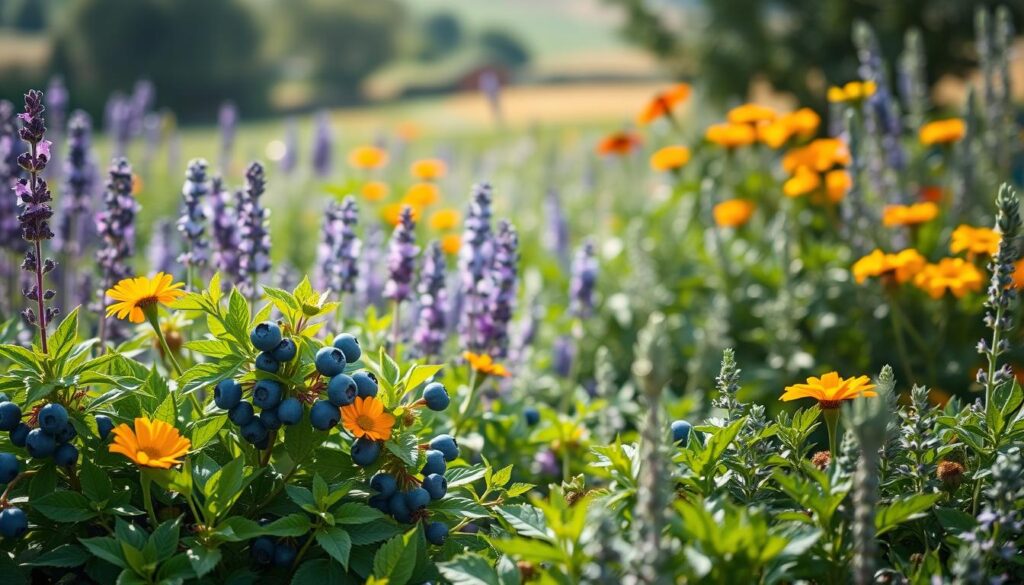
By selecting the best plants to pair with blueberries, you promote a healthy and vibrant garden environment. This integration of herbs, vegetables, and flowers not only maximizes growth but encourages a thriving ecosystem that benefits your blueberry plants in the long run.
Herbs to Consider as Companion Plants
Integrating the right herbs into your blueberry planting strategy can significantly enhance growth and crop performance. Choosing beneficial herbs for blueberry bushes helps foster a healthy environment, attracting pollinators and deterring pests. Here are some top herbs that boost blueberry growth and serve as excellent companions.
Basil: Flavorful and Beneficial
Basil not only adds a burst of flavor to your kitchen but also plays a vital role in the garden. This herb attracts beneficial insects that help protect blueberry bushes from harmful pests. Growing basil alongside your blueberries can lead to an overall healthier plant ecosystem and improved yields.
Mint: A Natural Pest Repellent
Planting mint near your blueberries offers dual benefits. Its strong aroma acts as a natural pest deterrent, which can keep destructive bugs at bay. In addition, mint is known to draw in pollinators, enhancing the pollination process for your blueberries. Consider this herb a must-have companion for your garden.
Oregano: Attracts Pollinators
Oregano serves as yet another valuable herb for your blueberry patch. This aromatic herb attracts various pollinators, contributing to improved fruit set and berry size. Grow oregano in close proximity to your blueberries for a visually appealing and productive garden space.

Compatible Vegetables with Blueberries
When planning your garden, considering compatible vegetables for blueberries can enhance both the growth and bounty of your plants. Certain vegetables thrive alongside blueberry bushes, allowing you to maximize your yield while efficiently using your garden space. Below are a few excellent vegetable companions for blueberry plants that you might consider incorporating.
Carrots: A Perfect Below-Ground Companion
Carrots make a fantastic below-ground companion for blueberries. They grow deep into the soil, minimizing competition for nutrients in the top layers. This symbiotic relationship can lead to healthier plants and potentially larger yields, as both crops enjoy the benefits of improved soil health.
Lettuce: Maximize Space and Growth
Lettuce offers an excellent opportunity to maximize space in your blueberry garden. As a fast-growing crop, lettuce can be harvested before the blueberry bushes fully mature. This means you can utilize the garden space effectively while ensuring both crops thrive together.
Spinach: Nutrient-Rich and Friendly
Spinach is another great addition to your blueberry garden due to its compatibility in terms of nutrient needs. This leafy green grows quickly and does not compete heavily for resources, allowing your blueberries to flourish. Including spinach not only enhances biodiversity in your garden but also adds essential nutrients to your overall harvest.
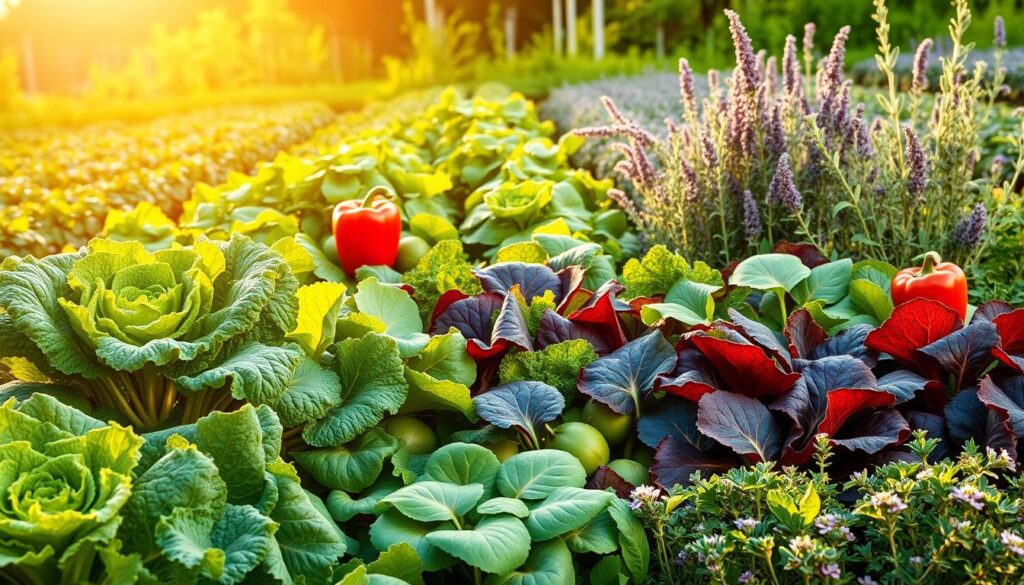
Pollinator-Attracting Flowers for Blueberries
Enhancing your blueberry garden goes beyond just the berries themselves. Incorporating the right pollinator flowers for blueberries can create a vibrant and healthy environment. These flowers not only beautify your space but also play a vital role in attracting beneficial pollinators such as bees, which are essential for optimal fruit production. Here are some fantastic choices:
Marigolds: Bright Blooming Allies
Marigolds are wonderful additions to your garden. Their bright blooms not only add visual interest but also serve as effective companion flowers for a healthy garden. By attracting bees with flowers, marigolds boost pollination rates while deterring pests that may harm your blueberries. Their ability to repel harmful insects enhances the overall health of your garden.
Lavender: A Scented Pollinator Magnet
Lavender stands out as a fantastic option for not only its beauty and fragrance but also its effectiveness in attracting pollinators. Planting this aromatic herb near your blueberries creates a delightful scent that draws in bees. Increased bee activity ensures that your fruit set is richer, making lavender an invaluable part of your landscape designed to attract bees with flowers.
Bee Balm: A Haven for Bees
Bee balm excels in luring diverse pollinators with its vibrant colors and nectar-rich blooms. This flower acts as a sanctuary for bees, enhancing pollination efforts and supporting healthy blueberry growth. By including bee balm in your garden, you’re not just beautifying the space; you’re also fostering a productive environment with pollinator flowers for blueberries.
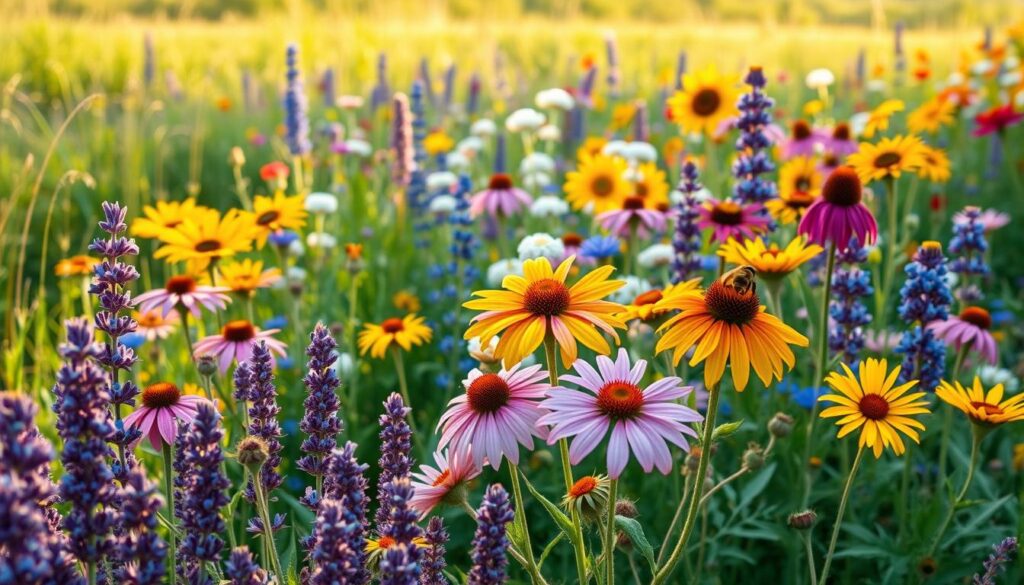
Avoiding Bad Companions for Blueberries
Growing blueberries is a rewarding experience, but ensuring you choose the right plant neighbors is crucial. Certain plants can negatively affect blueberry growth, making it essential to avoid poor plant choices with blueberries. Knowing which companions to skip helps promote healthy, thriving blueberry plants.
Plants to Skip for Healthy Growth
Some plants create unfavorable competition for blueberries, leading to stunted growth and reduced yields. Nightshades, such as tomatoes and peppers, flourish in alkaline soils, something blueberries do not favor. Brassicas like cabbage and broccoli also compete for precious nutrients. Grasses further complicate this by absorbing moisture and nutrients, hindering the blueberry’s development.
The Impact of Poor Plant Choices
Choosing the wrong plants can undermine your efforts in growing blueberries. Poor plant choices may lead to diseases, nutrient deficiencies, and an overall decline in plant health. By steering clear of plants that compete adversely with blueberries, you foster a healthier environment for your berry bushes to flourish.
Tips for Identifying Negative Companions
Being vigilant in identifying bad companions for blueberries can make all the difference. Pay attention to the plant’s growth habits and soil requirements. If a plant thrives in alkaline conditions or has a high nutrient demand, it’s best to avoid it alongside blueberries. Conducting research on potential neighbors before introducing them to your garden helps ensure you make beneficial decisions.
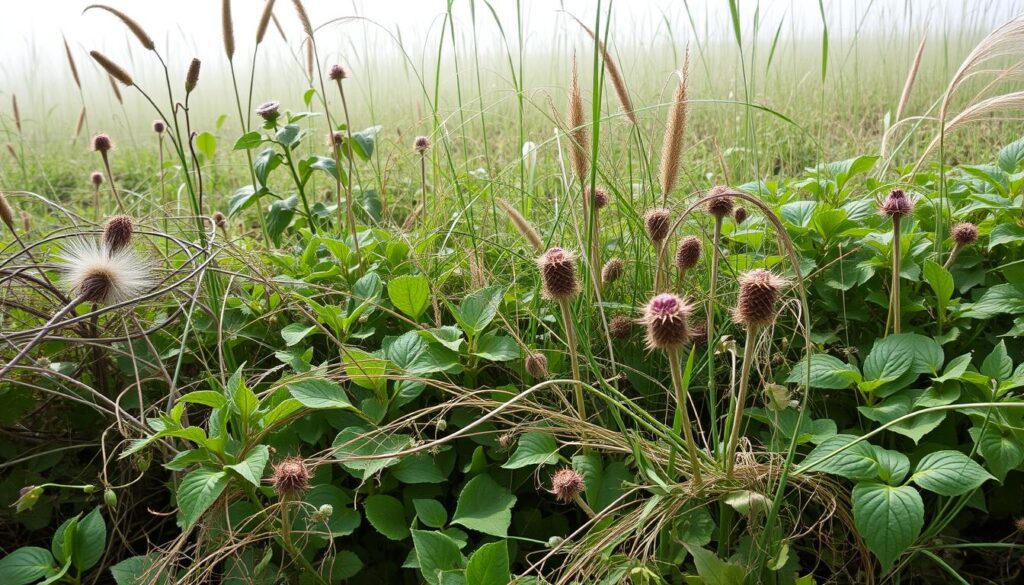
Seasonal Considerations for Companion Planting
Understanding the timing of your planting activities is key to successful gardening. Seasonal companion planting tips play a significant role in achieving optimal growth and yield for blueberries. By implementing companion plant strategies for blueberries tailored to the unique needs of each season, you can maximize the health and productivity of your garden.
Spring Companion Planting Strategies
Spring presents an ideal opportunity to start planting companion herbs and vegetables alongside your blueberries. Consider integrating plants like basil and oregano, which thrive together and help deter pests. This is the perfect time to assess soil conditions and enrich nutrient levels. Regular monitoring of moisture is crucial as your companion plants begin to establish themselves.
Summer Maintenance and Care
As the temperatures rise, attention shifts to maintaining healthy growing conditions. Regularly inspect your blueberry plants and their companions for signs of pests, making sure to address any issues promptly. Utilize mulch to retain soil moisture and suppress weeds, enhancing the growth of both blueberries and their companions. Staying proactive during the summer can lead to a successful harvest.
Fall Planting Tips for Blueberries
With the arrival of fall, it’s time to prepare for the cooler months. Before the first frost, finalize your harvesting and assess the arrangement of your blueberry and companion plants. Consider planting additional herbs that will withstand winter temperatures. By focusing on these seasonal companion planting tips, you’ll ensure longevity and health for your blueberry plants and their companions throughout the winter.

Soil Improvement Techniques for Blueberry Companions
Creating and maintaining healthy soil is crucial for the success of your blueberry plants as well as their companion plants. Implementing effective soil improvement techniques can significantly enhance soil health for blueberries, ensuring you achieve vigorous growth and bountiful yields.
Organic Amendments to Boost Soil Health
Incorporating organic amendments like compost or well-rotted manure into your garden can dramatically improve blueberry plant soil. These materials provide essential nutrients, enhance soil structure, and help retain moisture. As you prioritize enhancing soil health, consider adding a balanced mix of organic matter that suits the needs of both blueberries and their companions.
Mulching Benefits for Companion Plants
Mulching for soil moisture plays a key role in maintaining consistent hydration for your blueberry plants and their friends. Organic mulch materials, such as straw or wood chips, can regulate temperature, suppress weeds, and contribute to soil acidity—an essential factor for blueberries to thrive. Retroactively applying mulch will ensure your plants receive the moisture they need throughout the growing season.
pH Level Management Strategies
Managing soil pH is vital for improving blueberry plant soil. Blueberries prefer slightly acidic conditions, ideally between 4.0 and 5.5. Regular soil testing helps you monitor pH levels and adjust accordingly. Incorporating sulfur or other acidifying substances can create optimal conditions, allowing blueberries and their companions to flourish in harmony.
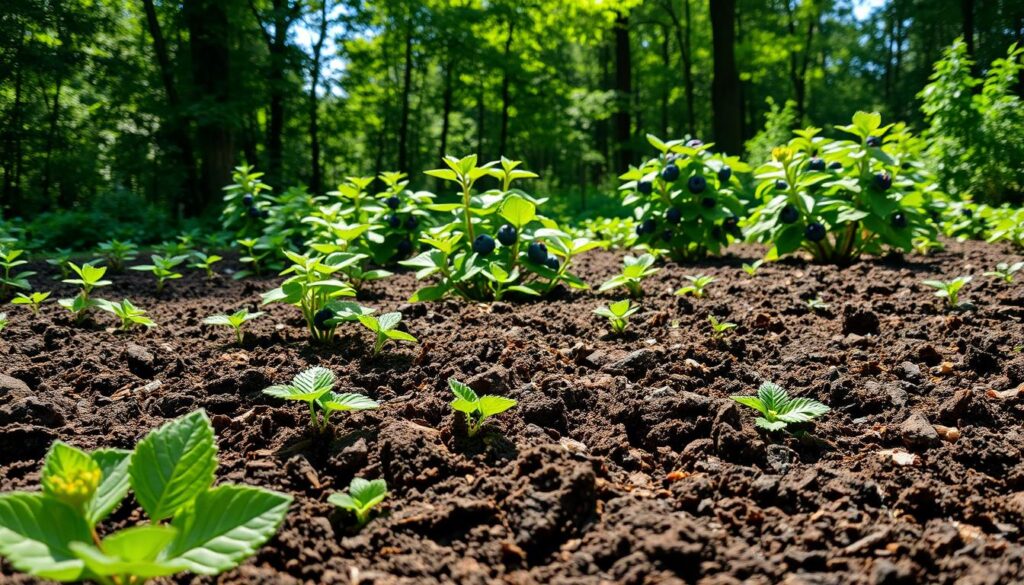
Companion Planting Layout and Design
An effective companion planting layout plays a crucial role in achieving healthy growth for blueberries and their companion plants. By following efficient garden planning for blueberries, you can create a thriving ecosystem that benefits both the blueberry plants and their neighbors. To maximize your garden space, consider various planting patterns that enhance pest control and pollination.
Planning Your Garden Space Efficiently
Start by measuring your garden area and evaluating the sunlight and water access. Grouping companion plants strategically works wonders in providing the necessary support for blueberries. Opting for companion planting patterns like alternating rows or clusters can help improve spatial efficiency while promoting healthy interactions between plants.
Companion Planting Patterns for Success
Utilizing companion planting patterns ensures that plants enhance each other’s growth and minimize competition. For instance, placing plants that attract beneficial insects near blueberries can significantly improve pollination and crop yields. Cultivating varieties that have similar growing requirements will create a cohesive ecosystem in your garden.
Using Raised Beds for Optimal Growth
Raised beds serve as an excellent solution for blueberries and their companions, providing superior soil drainage and structure. Efficient garden planning for blueberries becomes easier in a raised-bed system, allowing you to maintain soil quality while giving roots ample room to grow. These beds simplify maintenance tasks, creating an optimal environment for nurturing healthy plants.
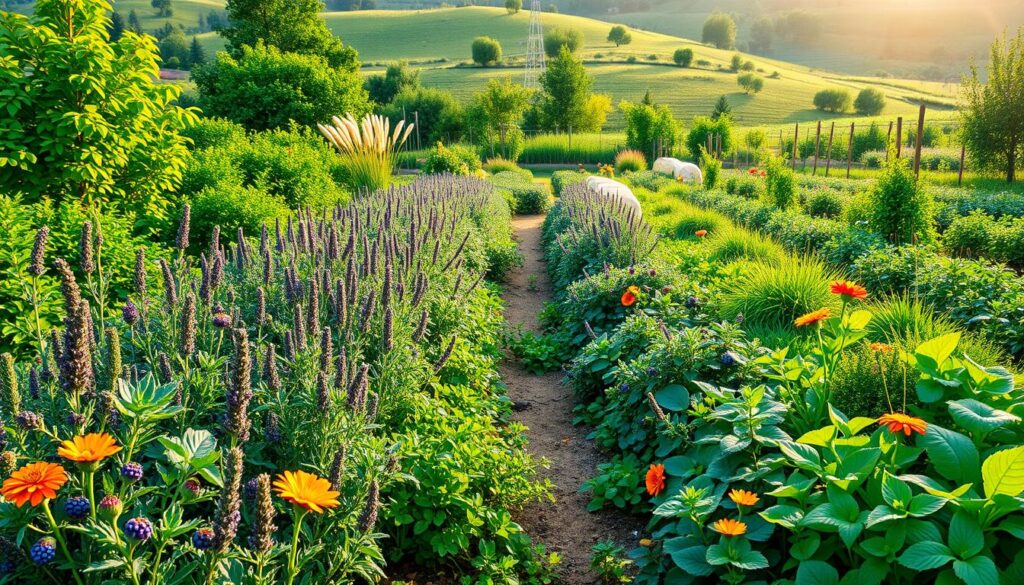
Harvesting Synergy: Timing Matters
Effective garden management involves understanding the timing of harvests, particularly when it comes to harvesting blueberries efficiently. By coordinating the harvest of blueberries with their companion plants, you can optimize your efforts and ensure a fruitful yield.
Coordinating Harvest Times for Efficiency
Harvesting blueberries in sync with companion crops allows for a smoother workflow. When you time harvests for companion plants properly, you can minimize labor and maximize your output. Check the maturity of each crop regularly to determine the best time for picking.
Understanding Growth Cycles of Companions
Every plant has its unique growth cycle, which directly impacts the timing of your harvests. By observing these cycles, you can identify periods of peak productivity. Planting species that mature at different intervals can ensure a staggered harvest, reducing pressure on your schedule and resources.
Tools to Help Simplify the Harvest Process
Utilizing the right tools can significantly improve your harvesting blueberries efficiently. Tools such as harvest baskets, clippers, and even specialized gatherers can streamline the process. Consider investing in high-quality supplies to enhance your overall gardening experience. These tools not only make the job easier but can also increase your productivity.
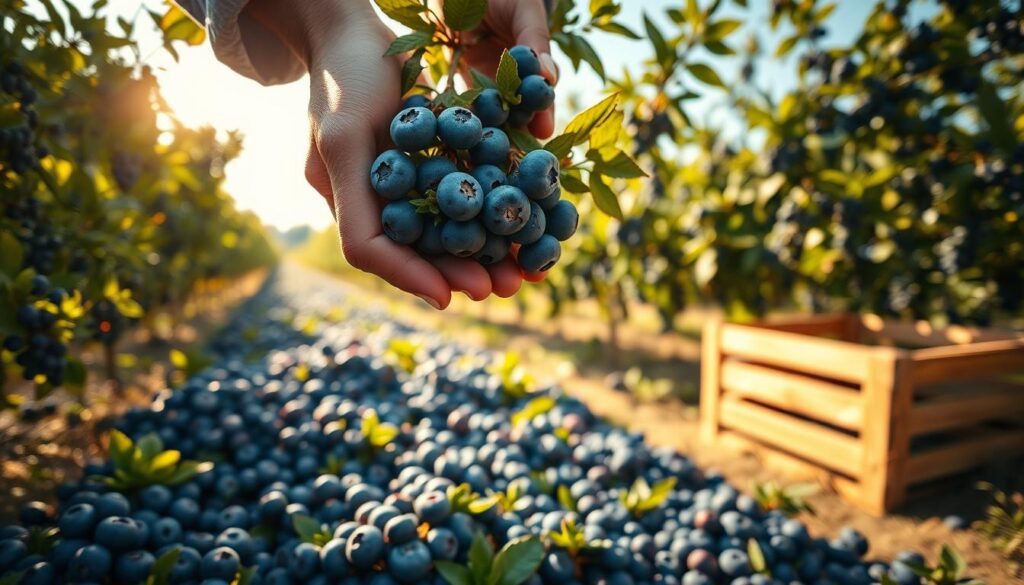
Troubleshooting Common Companion Planting Issues
When venturing into companion planting with blueberries, you may encounter several challenges. Addressing these common issues effectively leads to healthier plants and a more fruitful garden. This section delves into key aspects of troubleshooting blueberry companion issues, focusing on nutrient competition, pest management, and disease control. Understanding these elements prepares you to maintain a flourishing blueberry patch.
Identifying Competing Nutrients
Companion plants often compete for vital nutrients, impacting the health of your blueberries. Nutrient deficiencies manifest in various ways, including yellowing leaves or stunted growth. Regularly testing soil nutrient levels ensures that all plants receive the needed minerals. Strategies like rotating companions and maintaining proper spacing can prevent excessive competition.
Diagnosing Pest Challenges
When managing pests in blueberry gardens, vigilance is crucial. Monitor your plants for signs of infestations, such as discolored leaves or visible bugs. Implementing traps and introducing beneficial insects can help keep pests at bay. Maintaining garden hygiene, including removing debris, plays a significant role in pest prevention, reducing the chances of significant outbreaks.
Solutions for Disease Management
Employing disease management strategies in your garden safeguards blueberry and companion plant health. Recognizing early signs of plant stress or disease is essential. Choose disease-resistant cultivars and ensure proper airflow around plants. Regularly inspecting your garden can help identify issues before they escalate, leading to effective treatments.
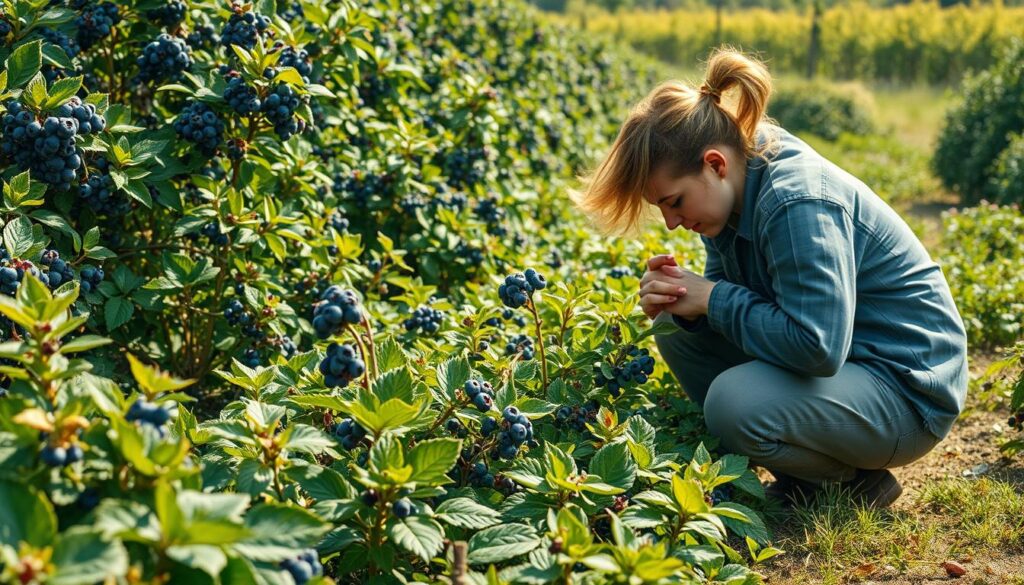
Conclusion: Maximizing Your Blueberry Harvest
As you delve into the world of companion planting, it’s essential to understand the multitude of benefits that can significantly enhance your blueberry gardening experience. Companion plants not only promote healthier growth but also help manage pests naturally and boost overall garden productivity. By ensuring that your blueberries are in the right environment, you’ll be on your way to maximizing blueberry harvest while reaping the rewards from companion planting.
Don’t hesitate to experiment with various plant combinations in your garden. Different companions can yield unique results, and through observing how they interact, you can fine-tune your approach. Each garden is distinct, so taking the time to assess what works for your specific conditions can empower you in your gardening journey.
To achieve a fruitful blueberry patch, remain consistent with your best practices for blueberry gardening. Ensure the right soil conditions, water levels, and sunlight exposure while incorporating compatible companion plants. By following these guidelines, you can cultivate a thriving garden rich with delicious blueberries and supportive plant companions, ultimately leading to a bountiful harvest.


